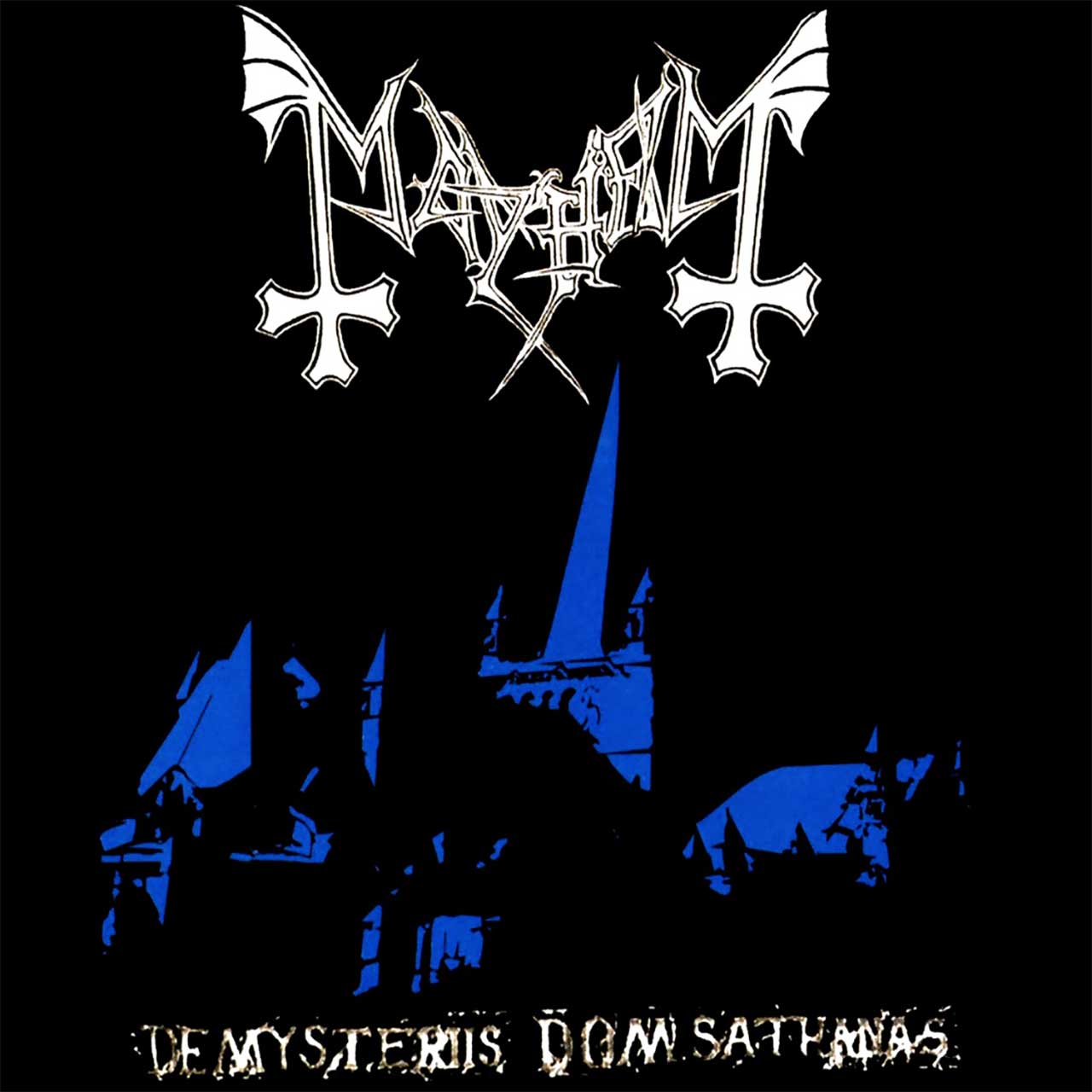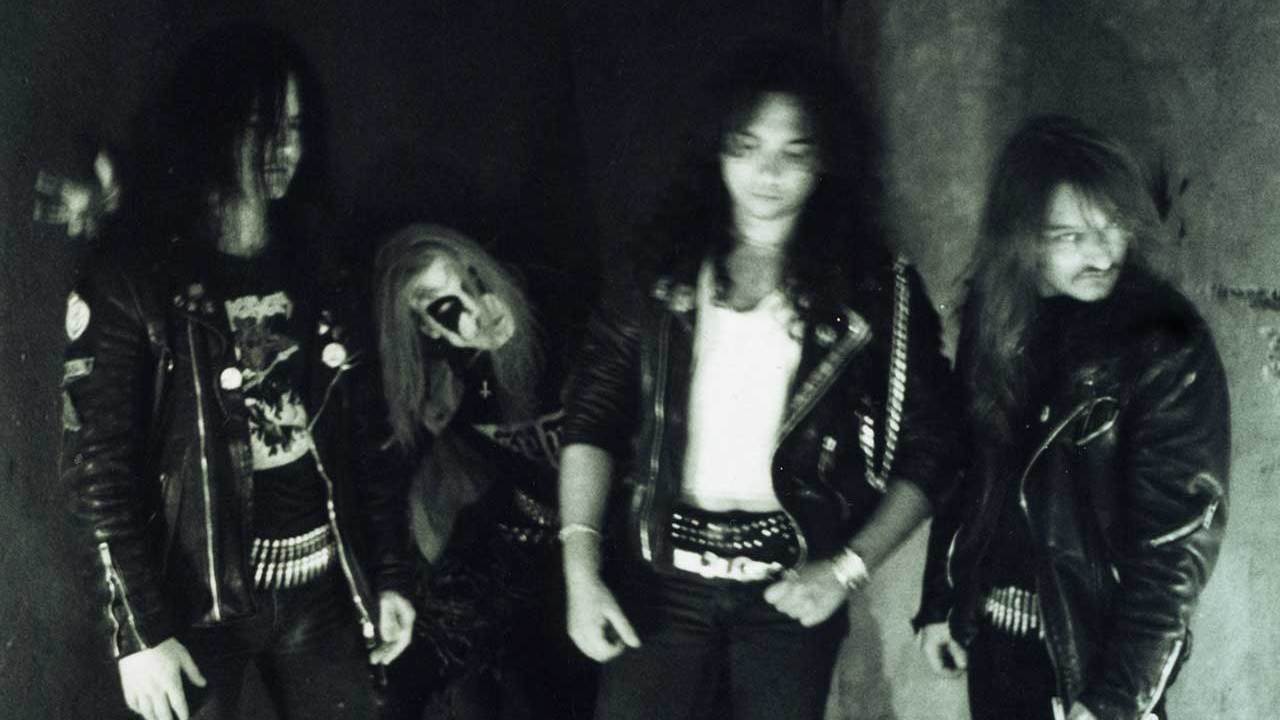It is an album whose significance, both inside and outside of black metal, has been acknowledged by a wealth of leading contemporary metal acts, from Watain to Enslaved to Inquisition, and one that led Nergal of Behemoth to proclaim it “the opus magnum of extreme metal”. Two decades after it was recorded, it continues to top ‘best album’ lists by longtime fans of the genre, while at the same time providing primary inspiration for new bands whose members were not even born when it was recorded. There are many who would say it is the single most important album in black metal’s broad and ever-growing catalogue, and very few who would argue that it is not, at the very least, a strong contender for that accolade.
The record in question is none other than Mayhem’s De Mysteriis Dom Sathanas, a milestone work that the long-serving Norwegians are set to perform in full around Europe this year, including Finland, Norway and France. And well they might, for this is an album that has lost neither its devoted following, nor any of its potency, in the years that have passed.

There are plenty of even more hyperbolic (yet equally true) statements that could be made in support of this unique collection of songs. Yet the biggest testament to its artistic value is perhaps the fact that discussion of its recording, songwriting and performance qualities continues to outweigh the highly notable circumstances of its creation. Indeed, it is testament to Mayhem’s significance as a musical force that any music was able to overcome all the drama involved with the band during the period in question. For – as most reading this will probably know – this is also a record that captures the vision of a musician who was not only cut down in his prime, but cut down by a bandmate appearing alongside him on this very recording.
The former party is of course Mayhem guitarist and co-founder Øystein ‘Euronymous’ Aarseth, who was stabbed to death in his apartment in August 1993 by the latter, Varg Vikernes, best known for his similarly-influential project Burzum but also the bassist for Mayhem during the era of De Mysteriis’ creation. The ultimately fatal conflict between the two men is a long and complicated episode in black metal’s grim history that has been discussed at length by fans and media alike for two decades.
What is still worth noting today though, is that the album’s roots are intrinsically linked to two now-departed members of the band. The second is the Swedish-born vocalist Per Yngve Ohlin – otherwise known as ‘Dead’ – and in fact it was he who actually came up with the title; Latin for ‘Of Lord Satan’s Mysteries / Secret Rites’, and a title taken, he explained, from an occult book he had discovered. The fact that Dead took his own life in 1991, while the album was released in 1994, gives some idea of how long the band’s debut studio album was in gestation.
Certainly it was long enough that the band’s first full-length, the legendary live album Live In Leipzig, (recorded in November 1990 but released almost three years later) captured the band (the line-up then comprised of Dead, Euronymous, bassist Necrobutcher and drummer Hellhammer) performing no less than half of its eight numbers. The oppressive, melancholic and suffocating aura found on that recording would thankfully remain in place following the transition of these aforementioned songs to the studio. While the obvious standout track Freezing Moon ia a grim monochromatic epic that remains a fan favourite even today – the unholy and, well, freezing feeling within that song is just as present on Funeral Fog, Pagan Fears, Buried By Time And Dust.
Complementing these older compositions and undoubtedly giving the album a more three-dimensional character was the incorporation of four newer, somewhat more angular and twisting songs, namely the title track, Cursed In Eternity, Buried By Time And Dust and From The Dark Past. Euronymous’ playing had become somewhat more calculated and considered by this point, his writing influenced significantly by the introverted but talented guitarist Snorre Ruch, whose unique approach to riffing within his band Thorns had proven ridiculously influential within the Norwegian scene. In fact, Snorre (now going under the name ‘Blackthorne’) would be inducted into the group as a second guitarist prior to the album’s recording. Despite not appearing on the finished record, he would contribute entire Thorns riffs to several songs, his presence being felt not only during these moments but more generally through his impact on much of Euronymous’ creeping guitar work.
His other role would be to rearrange Dead’s lyrics on several songs in preparation for the deceased vocalist’s replacement, Attila Csihar. A Hungarian musician who was admired in Norway thanks to his short-lived but seminal black metal band Tormentor, his appointment and spirited performance remains a defining factor of the record, and it was one that provoked no small controversy at the time. In contrast to the more typical black metal vocal styles of the time he introduced an eccentric, otherworldly and theatrical approach incorporating a drawling delivery and lurching from screams and rasps to an almost operatic form of singing that makes a feature of his distinctive Hungarian accent.
“The way of singing it, we were talking about how to do it of course,” recalled Attila in an interview conducted back in 2009. “I heard some demo recordings that had been done by Dead and [previous vocalist] Maniac before, but I like individualism… so when I talked to Euronymous in the studio I said, ‘Why don’t we try something else instead of making again the traditional screamed vocals?’ The De Mysteriis Dom Sathanas song, when I looked at the lyrics there was this Latin line so I thought, ‘Let’s do this voice there.’ I came out with the low vocals with more melodies, and he liked it so much we did the whole recording that way.”
Though seemingly a long-running plan on the part of Euronymous, the decision to use Attila for the role proved as much of a surprise for other musicians in the Norwegian scene as it was for the Mayhem fanbase. After all, not only was Euronymous surrounded by an abundance of local talent, but many of the vocalists in the country actually knew the songs on the forthcoming album already, having listened repeatedly to an instrumental tape that had been making the rounds for some time.
“People were a little bit pissed that they didn’t receive the phone call,” recalled Grutle of Enslaved during the same interview, “but they thought, ‘Well that’s going to be interesting’ – and it was! Actually while [Attila was] doing the vocals Øystein went to the callbox and called me and said, ‘He sings like a sick priest, he sings in Latin, with an accent, it’s incredible!’”
Of course, one cannot mention De Mysteriis without mention of the pounding and detailed percussion that underpins it. A fine performance by one of black metal’s best known drummers, Hellhammer (a man who has performed for innumerable bands from Arcturus and Covenant to Dimmu Borgir and Shining), the formidable yet restrained drumwork is complimented by both the spacious, eerie and strangely minimal bass work and a powerful and gloriously unpolished production. The latter is no small factor in the album’s success and was apparently the result of a considerable amount of work on the part of both Euronymous and the infamous Pytten, a producer who spent much of the 1990s capturing iconic works by legends such as Enslaved, Burzum, Hades, Gorgoroth and Immortal.
“Euronymous had specific ideas about each instrument and he had specific ideas about echoes,” recalled Attila. “The drums were recorded in a huge concert hall, solos were recorded in a room and he was moving round all the time and saying, ‘Okay, there we have it.’ If you listen to records from the time and then De Mysteriis you hear the production is far and away better than anything else.”
“The whole album was recorded in very spacious areas,” confirmed producer Pytten. “Øystein, Hellhammer and me were walking about, talking about how to do it and I really wanted to use the stage for the drums. I really like big sounds — especially for the drums — and reverb on the leads. So the drums were done on stage and [in that hall] you have nine stories going up, so we closed the room side, but kept all the height.”
It isn’t only the drums that utilise large numbers of tracks, another defining ingredient in the album is the mass of multi-tracked guitars, which create a huge (yet suitably icy and treble-heavy) wall of sound, a perfect compliment to the similarly sizeable percussive bombardment. Indeed, the combination only accentuates the crushing and malevolent character of the whole record, the overall effect being a dense and impenetrable assault on the senses, one only balanced by the surprising touches of groove throughout the album.
And this is perhaps the last thing to underline, particularly for newcomers to the record. Though undeniably a standout opus, it is not an easily accessible work – even by black metal standards – and is not necessarily a gateway album. Nor is it meant to be. It is a purposely gloomy and aggressive beast, and one that makes no concessions to outsiders, instead following its own wilful and destructive path without any apology. Give it the time it deserves however, and it will be with you forever. We can only hope that its forthcoming live invocations are equally memorable.
The interviews in this piece were originally conducted for the book Black Metal: Evolution Of The Cult and appear in an extended form there. The book and its sequels are available at now.
